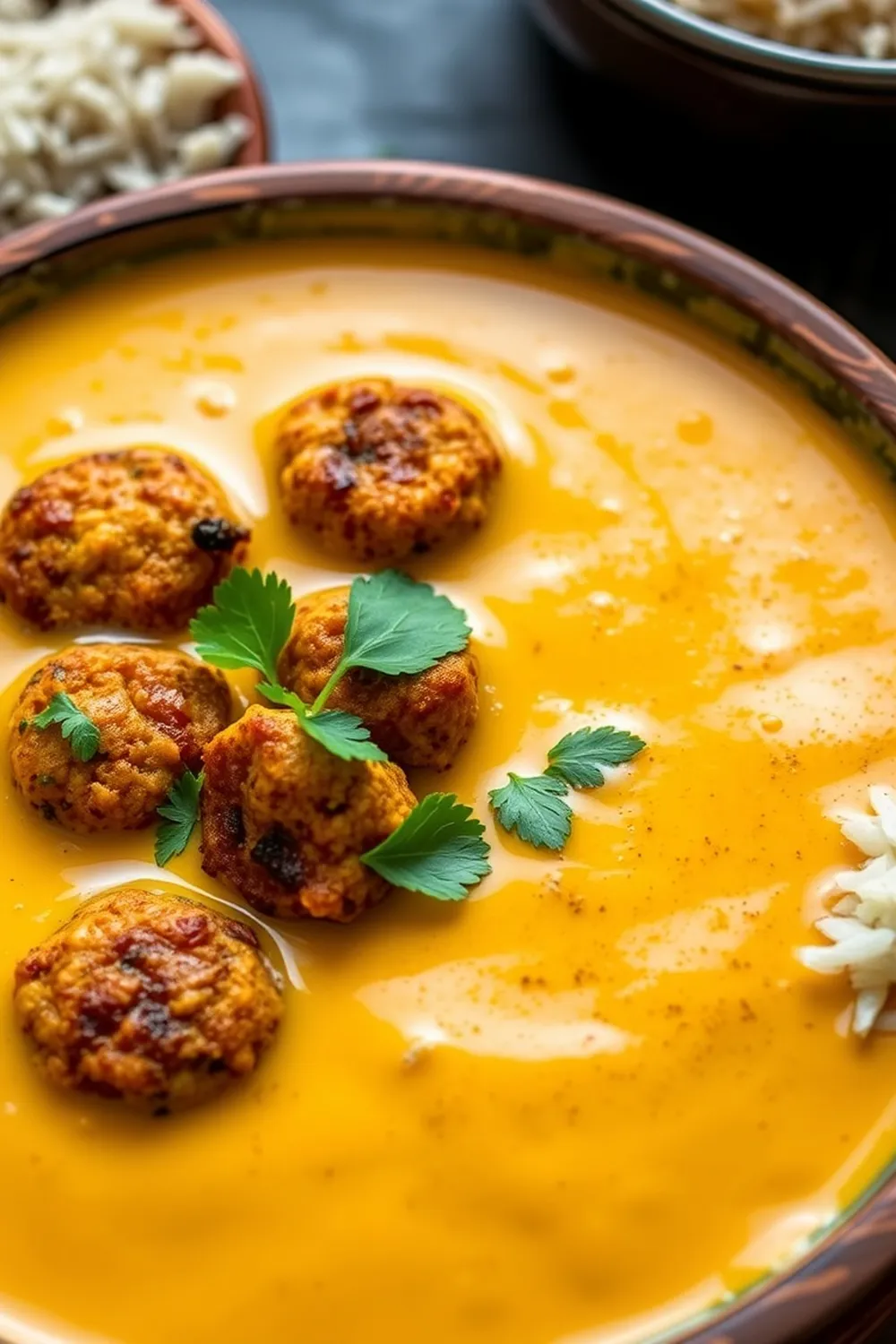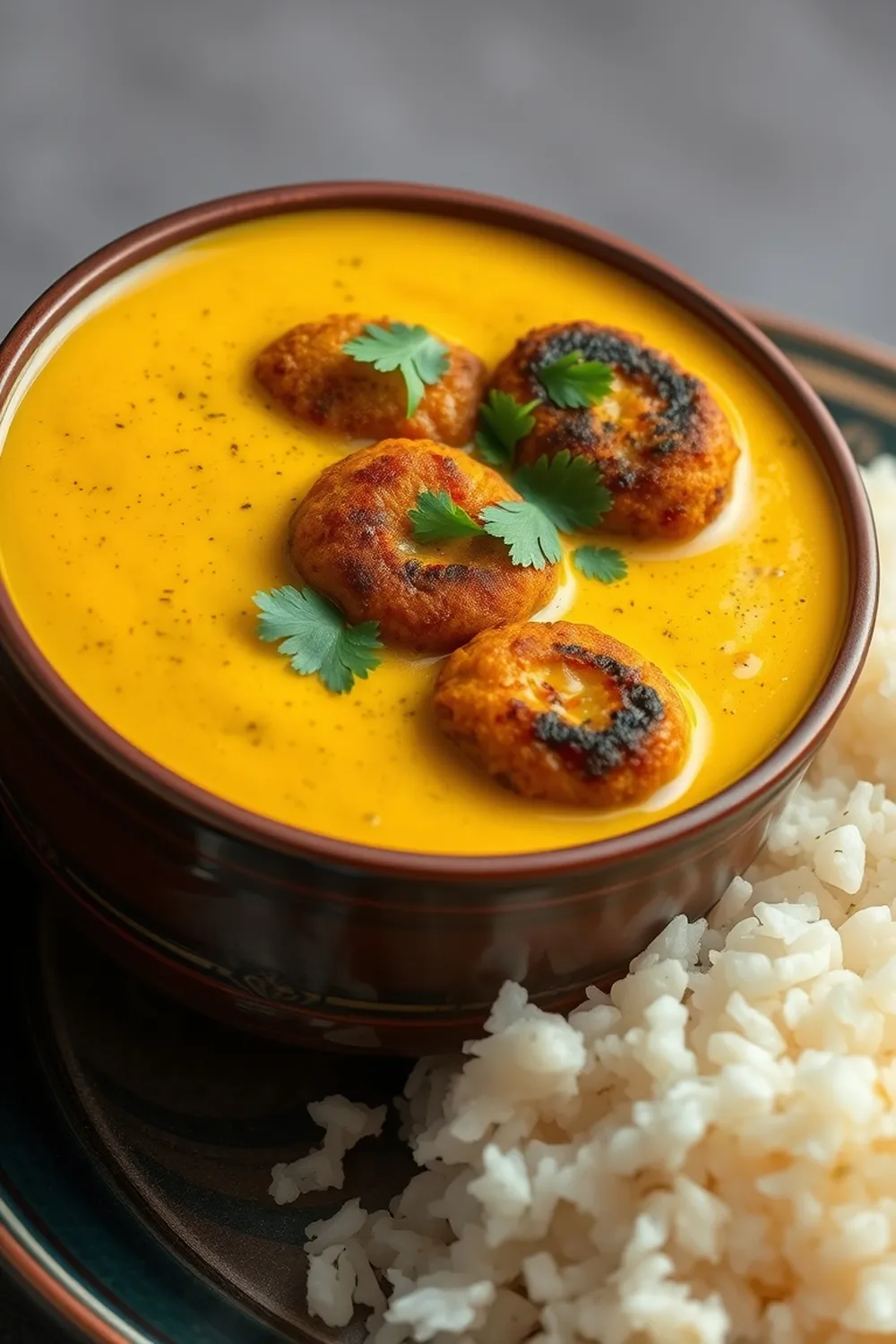- Wash and finely chop fenugreek (methi) leaves. In a bowl, combine fenugreek leaves, gram flour, yogurt, and salt to form a sticky batter.
- Heat oil for frying. Shape small portions of the batter into pakoras and deep-fry until golden brown and crispy. Drain on a kitchen towel.
- For kadhi: Whisk yogurt, water, gram flour, turmeric powder, and salt in a bowl until smooth.
- Heat oil in a pan. Add cumin seeds, green chilies, and asafoetida. Sauté until fragrant.
- Add sliced onions and cook until translucent. Pour in the yogurt mixture and simmer on low-medium heat for 10-15 minutes, stirring frequently to prevent curdling.
- Transfer kadhi to a serving bowl. Add pakoras just before serving. Serve hot with rice or roti.
- Calories:280 kcal25%
- Energy:1171 kJ22%
- Protein:10 g28%
- Carbohydrates:30 mg40%
- Sugar:5 mg8%
- Salt:450 g25%
- Fat:12 g20%
Last Updated on 6 months ago by Neha Deshmukh
Methi Pakora Kadhi Recipe – Authentic Indian Curry & Fritters
Hello friends! Today, I’m sharing a recipe that’s close to my heart – Methi Pakora Kadhi. It’s a beautiful harmony of crispy, flavorful pakoras swimming in a tangy, comforting kadhi. This dish always reminds me of my grandmother’s cooking, and I’m so excited to share her legacy with you. It’s a little bit of work, but trust me, every bite is worth it!
Why You’ll Love This Recipe
This Methi Pakora Kadhi isn’t just a meal; it’s an experience. The slightly bitter, earthy notes of the methi (fenugreek) leaves in the pakoras are perfectly balanced by the creamy, tangy kadhi. It’s a dish that’s both satisfying and incredibly flavorful. Plus, it’s a fantastic way to enjoy seasonal methi leaves! It’s perfect for a cozy weeknight dinner or a special occasion.
Ingredients
Here’s what you’ll need to make this delicious Methi Pakora Kadhi:
- 1 cup methi leaves (approximately 100g)
- 1 cup besan (gram flour) (approximately 120g)
- 1 cup curd (plain yogurt) (approximately 240ml)
- Salt to taste
- Oil for deep frying
- 1 cup curd (plain yogurt) (approximately 240ml)
- 1 cup water (approximately 240ml)
- 2 tbsp besan (gram flour) (approximately 24g)
- 3 tsp oil
- 1 onion, thinly sliced
- 2 green chilies, slit
- 1 tsp cumin seeds
- 2 pinches asafoetida (hing)
- ½ tsp turmeric powder (approximately 2g)
Ingredient Notes
Let’s talk ingredients! A few things can really make or break this dish:
- Methi Leaves: Freshness is key here! Look for vibrant green leaves that aren’t wilted or yellowing. They have the best flavor when they’re young and tender.
- Besan (Gram Flour): Use a good quality besan for the best texture and flavor. Sometimes, older besan can have a slightly bitter taste, so check the expiry date.
- Kadhi Consistency & Spice Levels: Kadhi is a very regional dish. Some families prefer a thicker kadhi, while others like it thinner. Adjust the water quantity to your liking. Similarly, spice levels vary – feel free to add more or fewer green chilies!
- Curd (Yogurt): I prefer using slightly sour curd for the kadhi, as it adds a lovely tang.
Step-By-Step Instructions
Alright, let’s get cooking!
- First, wash and finely chop the methi leaves. Don’t worry about being too precise – a little bit of texture is nice.
- In a bowl, combine the chopped methi leaves, besan, curd, and salt. Mix well until you get a slightly sticky batter. If it’s too thick, add a tablespoon of water at a time.
- Heat oil for deep frying in a kadai or deep pan.
- Shape small portions of the methi batter into pakoras (think little patties or fritters) and carefully drop them into the hot oil.
- Fry the pakoras until they’re golden brown and crispy. This usually takes about 3-4 minutes per batch.
- Remove the pakoras with a slotted spoon and drain them on a kitchen towel to remove excess oil.
- Now, let’s make the kadhi! In a separate bowl, whisk together the curd, water, besan, turmeric powder, and salt until everything is smooth and lump-free.
- Heat oil in a pan over medium heat. Add the cumin seeds, green chilies, and asafoetida. Sauté for a few seconds until fragrant – this is where the magic starts!
- Add the sliced onions and cook until they turn translucent and slightly golden.
- Pour in the curd mixture and bring it to a simmer. Reduce the heat to low-medium and cook for 10-15 minutes, stirring frequently to prevent it from sticking to the bottom. The kadhi will thicken as it cooks.
- Finally, transfer the kadhi to a serving bowl. Gently add the freshly fried methi pakoras just before serving.
Expert Tips
- Don’t overcrowd the pan when frying the pakoras. Fry them in batches to ensure they cook evenly and stay crispy.
- Stir the kadhi constantly, especially towards the end, to prevent it from scorching.
- A pinch of red chili powder can add a nice touch of heat to the kadhi.
Variations
This recipe is pretty versatile! Here are a few ways to customize it:
- Vegan Adaptation: Swap the curd with plant-based yogurt (like cashew or soy yogurt) for a delicious vegan version.
- Gluten-Free Adaptation: Ensure your besan (gram flour) is sourced from a gluten-free facility, as some brands may process it alongside wheat.
- Spice Level Adjustments: My family loves a bit of a kick, so we often add a pinch of cayenne pepper to the kadhi. Feel free to adjust the green chilies or add red chili powder to suit your taste.
- Festival Adaptations: This dish is often made during Makar Sankranti and other harvest festivals in North India. It’s considered an auspicious and warming meal.
Serving Suggestions
Serve Methi Pakora Kadhi hot with a side of fluffy steamed rice or warm rotis. A dollop of ghee on top of the kadhi adds extra richness and flavor. It’s also lovely with a side of simple raita (yogurt dip).
Storage Instructions
Leftover kadhi can be stored in an airtight container in the refrigerator for up to 2 days. The pakoras are best enjoyed fresh, as they tend to lose their crispness when stored. If you have leftover pakoras, you can reheat them in a preheated oven or air fryer to crisp them up.
FAQs
Let’s address some common questions:
1. What is the best way to prevent the Methi Pakoras from becoming soggy?
Fry them in hot oil and don’t overcrowd the pan. Also, make sure to drain them on a kitchen towel immediately after frying.
2. Can I make the Kadhi ahead of time? If so, how should I store it?
Yes, you can! Make the kadhi (without the pakoras) and store it in an airtight container in the refrigerator for up to 2 days. Reheat gently before serving and add the freshly fried pakoras.
3. What is Asafoetida (Hing) and can I substitute it?
Asafoetida, or hing, has a pungent aroma but adds a unique savory flavor to Indian dishes. If you can’t find it, you can omit it, but it does contribute to the authentic taste.
4. What type of oil is best for frying the Pakoras and for tempering the Kadhi?
For frying, a neutral-flavored oil like vegetable or canola oil works well. For tempering the kadhi, ghee (clarified butter) adds a lovely flavor, but you can also use mustard oil or vegetable oil.
5. My Kadhi is too sour, how can I balance the flavors?
Add a teaspoon of sugar or jaggery to the kadhi to balance the sourness.
6. Can I use frozen methi leaves for this recipe?
While fresh methi leaves are best, you can use frozen ones in a pinch. Thaw them completely and squeeze out any excess water before using. The flavor won’t be quite as vibrant, but it will still be delicious.
Enjoy making this Methi Pakora Kadhi! I hope it brings as much joy to your table as it does to mine. Let me know how it turns out in the comments below!










